Samsung 870 EVO Incoming? New SATA Drive Likely Landing Soon
German publication has WinFuture reported that Samsung is revamping and reviving the company's EVO series of SSDs. The South Korean giant is on the verge of announcing the new Samsung 870 EVO lineup.
The Samsung 870 EVO, which is reportedly listed at several European and North American retailers, will arrive in the common 2.5-inch form factor and rely on the standard SATA III interface. It's unclear if Samsung will offer the SSD in mSATA and M.2 2280 flavors like the company has done in the past.
The exact model of the SSD controller and NAND chips inside the Samsung 870 EVO remains an enigma for now. If the drive is anything like its predecessor, the Samsung 860 EVO, we could potentially see the use of TLC (triple-level cell) memory -- or as Samsung likes to call it, 3-bit MLC (multi-level cell) V-NAND.
Samsung 870 Evo Specifications
| Product | Form Factor | Capacity | Sequential Read (MBps) | Sequential Write (MBps) | Random Read (IOPS) | Random Write (IOPS) | Endurance (TBW) | Warranty |
|---|---|---|---|---|---|---|---|---|
| Samsung 870 Evo | 2.5 inch | 250GB, 500GB, 1TB, 2TB, 4TB | Up to 560 | Up to 530 | ? | ? | Up to 2,400 | 5 Years |
| Samsung 860 Evo | 2.5 inch, mSATA, M.2 | 250GB, 500GB, 1TB, 2TB, 4TB | Up to 550 | Up to 520 | Up to 98,000 | Up to 90,000 | Up to 2,400 | 5 Years |
| Samsung 850 Evo | 2.5 inch, mSATA, M.2 | 120GB, 250GB, 500GB, 1TB, 2TB, 4TB | Up to 540 | Up to 520 | Up to 98,000 | Up to 90,000 | Up to 300 | 5 Years |
| Samsung 840 Evo | 2.5 inch | 120GB, 250GB, 500GB, 750GB, 1TB | Up to 410 | Up to 520 | Up to 98,000 | Up to 90,000 | N/A | 3 Years |
Capacity-wise, the Samsung 870 Evo won't come with any surprises. According to WinFuture, Samsung will offer the drive in five primary capacities: 250GB, 500GB, 1TB, 2TB and 4TB. This was to be expected since Samsung hasn't offered a 120GB EVO drive since the 850 EVO days.
The Samsung 870 Evo reportedly delivers sequential read and write speeds up to 560 MBps and 530 MBps, respectively. This represents a minor performance improvement (10 MBps) over the previous Samsung 860 EVO lineup.That's not surprising since the Samsung 870 EVO, like its antecessors, is constricted to the SATA III interface. The drive's random performance is unknown at the moment.

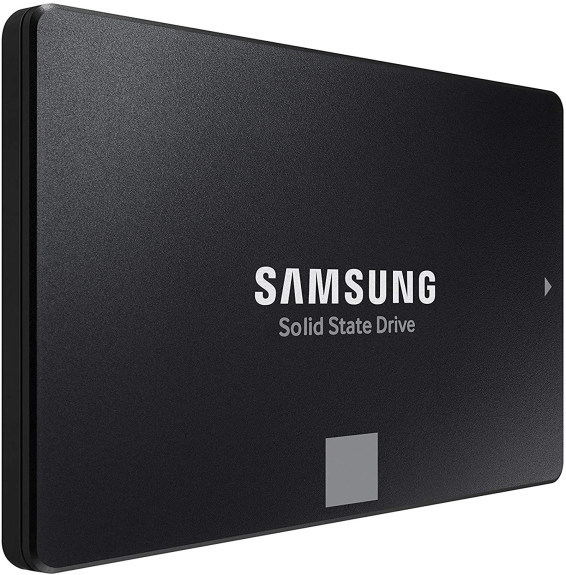


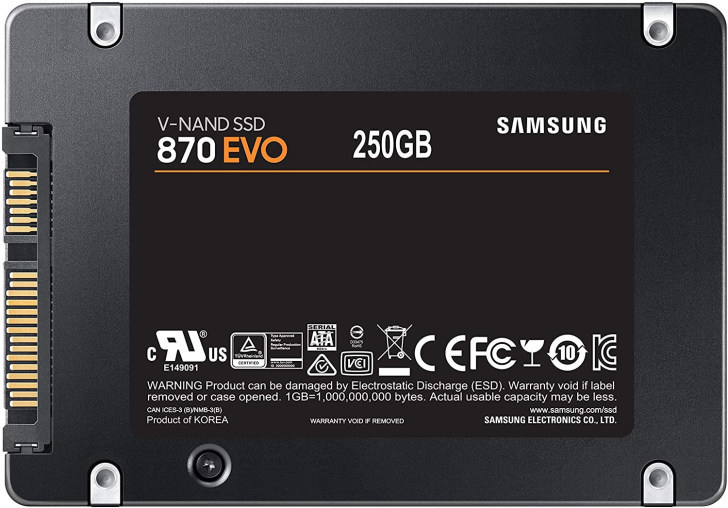
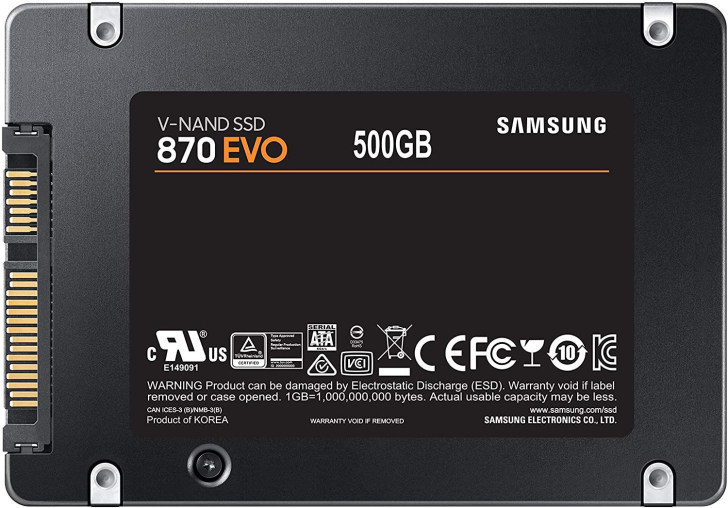
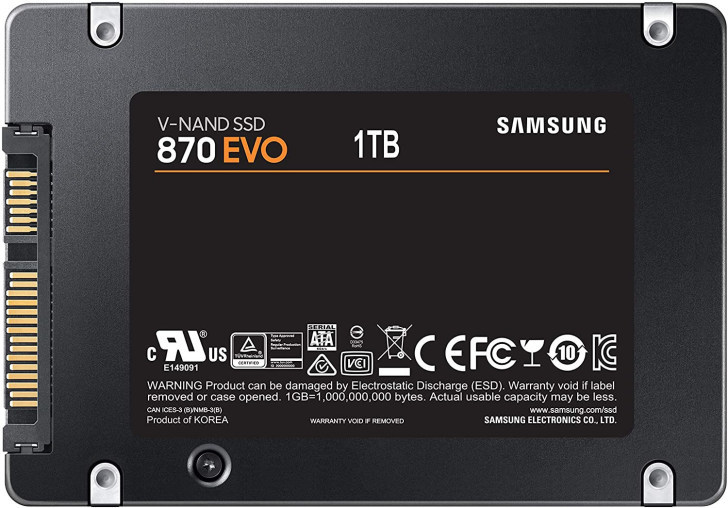

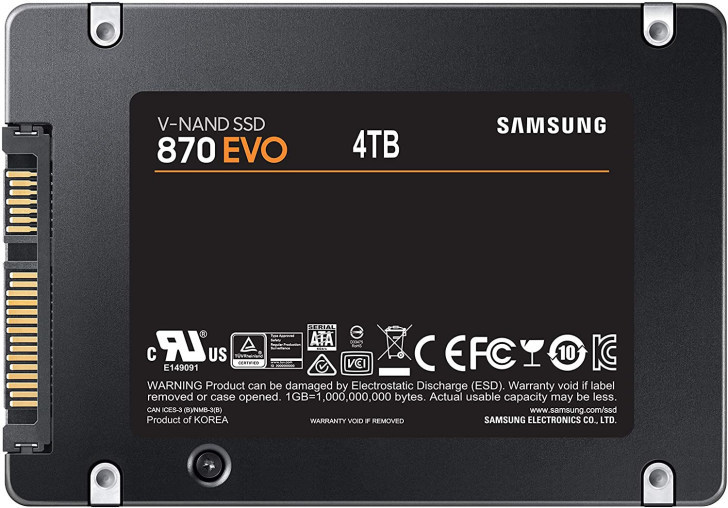
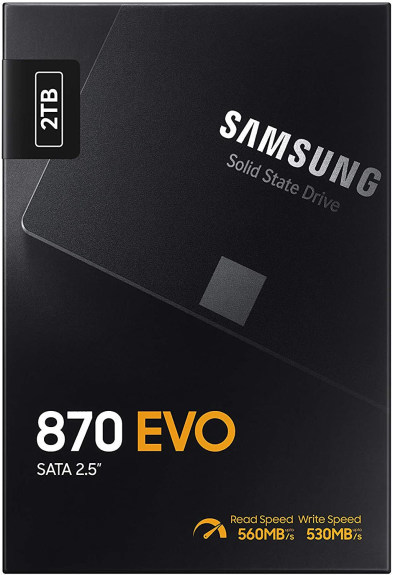
The Samsung 870 EVO could also just be a humble refresh of the Samsung 860 Evo if WinFuture's information on the drive's endurance is accurate. The 4TB variant is purportedly rated for 2,400 TBW (terabytes written), which is the same rating for the Samsung 860 Evo 4TB model. Samsung will likely back the SSD up with the company's usual limited five-year warranty.
In regards to pricing, the Samsung 870 EVO allegedly retails for between 70 and 450 euros (~$85 to $548), depending on the capacity. The German news outlet didn't specify where it saw the pricing though, so it's impossible for us to guess which VAT (value-added tax) rate to use in our calculations. For reference, the Samsung 860 EVO 250GB and 4TB costs $44.99 and $499.99 in the U.S.
Get Tom's Hardware's best news and in-depth reviews, straight to your inbox.

Zhiye Liu is a news editor, memory reviewer, and SSD tester at Tom’s Hardware. Although he loves everything that’s hardware, he has a soft spot for CPUs, GPUs, and RAM.
-
Loadedaxe Not sarcasm at all, but do people really buy Samsung EVO Sata drives? They cost as much as a decent nvme. And all boards in the last few years usually have at least 2 nvme slots. I havent used a sata drive in years.Reply -
USAFRet Reply
Yes. I just bought a 1TB 860 EVO. It will go in place of a 250GB 840 EVO, which will find another purpose elsewhere.Loadedaxe said:Not sarcasm at all, but do people really buy Samsung EVO Sata drives? They cost as much as a decent nvme. And all boards in the last few years usually have at least 2 nvme slots. I havent used a sata drive in years.
Price parity SATA -> NVMe is only very very recent. And even then, not between comparable devices.
And given only one or two M.2 ports, adding more storage means...SATA.
And, there really isn't a LOT of difference in user facing performance. Yes, benchmark difference is huge. But actual screen time isn't.
Lastly, not everyone ups their hardware all the time. My current system (specs below) works for my purposes, and a good NVMe would be wasted in it. Late this year a new system may be in the offing, but not a critical change. -
mdd1963 Can't imagine anyone intentionally using SATA as a primary OS/application drive in lieu of NVME M.2 for new systems....; however, there are millions of desktops and laptops probably still using 2.5" or 3.5" spinning SATA drives that would be prime candidates for an 860/870 EVO or Crucial MX500... (I agree, the prices should be noticeably less than NVME, however...)Reply -
Geef ReplyLoadedaxe said:Not sarcasm at all, but do people really buy Samsung EVO Sata drives? They cost as much as a decent nvme. And all boards in the last few years usually have at least 2 nvme slots. I havent used a sata drive in years.
There are good reasons for using SATA drives you might not immediately think about. For work I have a friend who has a bunch of SATA drive clones and swaps them between machines and laptops frequently. Very useful and no need to be careful about an NVME chip getting dropped or broken. Awesome performance and easy to move around. -
QSV Reply
Theres a huge difference in speed between a good NVMe drive and a SATA drive like the 860 Evo.USAFRet said:Yes. I just bought a 1TB 860 EVO. It will go in place of a 250GB 840 EVO, which will find another purpose elsewhere.
Price parity SATA -> NVMe is only very very recent. And even then, not between comparable devices.
And given only one or two M.2 ports, adding more storage means...SATA.
And, there really isn't a LOT of difference in user facing performance. Yes, benchmark difference is huge. But actual screen time isn't.
Lastly, not everyone ups their hardware all the time. My current system (specs below) works for my purposes, and a good NVMe would be wasted in it. Late this year a new system may be in the offing, but not a critical change.
You can easily notice it. And no, I am not talking about file copy speeds. -
USAFRet Reply
In what use case?QSV said:Theres a huge difference in speed between a good NVMe drive and a SATA drive like the 860 Evo.
You can easily notice it. And no, I am not talking about file copy speeds.
Quantify this, please.
Yes, an NVMe is faster. Often noticeable faster.
Often not.
4YoRKQy-UO4View: https://www.youtube.com/watch?v=4YoRKQy-UO4 -
Nemesia ReplyQSV said:Theres a huge difference in speed between a good NVMe drive and a SATA drive like the 860 Evo.
You can easily notice it. And no, I am not talking about file copy speeds.
Corrected it.
"Theres is a 1 second difference in speed loading your OS, game or program between a good NVMe drive and a SATA drive like the 860 Evo.
You can barely notice it when the OS boot and when a game or map is loading. Files transfer is the only real advantage from and to the same or another NVMe."
4YoRKQy-UO4View: https://www.youtube.com/watch?v=4YoRKQy-UO4 -
Conahl ReplyLoadedaxe said:Not sarcasm at all, but do people really buy Samsung EVO Sata drives? They cost as much as a decent nvme
actually, i just picked up 5 860 evo 1TB drives over the last 2 weeks thanks to boxing week sales :-) 1 will be going into my notebook to replace the 750 gig WD black drive, 2 others, replacing 2 WD 1TB drives in my main system, the other 2, i havent decided where they will go, yet, but at $139 cdn, i figured why not ? :) cant go nvme as no more free m.2 ports, and notebook only has sata, the price of the 2, 1 TB 970 evos + add on m.2 card for my main system was more then the 2 860 evo drives would of been, and for just storage, really no need for nvme drives. -
Darkbreeze Not sure where anybody thinksReply
Loadedaxe said:Not sarcasm at all, but do people really buy Samsung EVO Sata drives? They cost as much as a decent nvme.
No, they really don't in a lot of cases.
For example.
A 1TB Samsung 860 EVO currently runs about 109.99. A current 1TB Samsung 970 EVO runs about 140 bucks. So, that's a 30 dollar difference.
30 bucks might mean the difference between getting a a crappy PSU or a decent one. 30 bucks could be the difference between a bottom tier motherboard and a middle tier motherboard with much better quality and features.
Moving on, a 2TB 860 EVO currently runs about 200 bucks. A 2TB 970 EVO Plus, which is the least expensive Samsung NVME 2TB M.2 drive, runs about 320 bucks. That's a 120 dollar difference.
A 1TB Crucial MX500 runs 90 bucks. A 1TB Crucial P2 also runs about 90 bucks, but, it's random performance is pretty terrible when compared to the Samsung 970 EVO Plus and isn't actually much better than the MX500 SATA drive. Still yet, I'd agree that AT THIS TIME, the P2 would be the better choice as the primary OS drive for systems that can support it. Those prices might be significantly different before long, when the prices of these drives go up due to what they are saying will be controller shortages.
Moving on again, the 2TB MX500 is 180 bucks. The 2TB P2 is 225 bucks. A 45 dollar difference. Again, that might well be better spent towards some other hardware when the fact is that the random performance, which is where most OS drives "live" the majority of the time, isn't terribly different and I think anybody who is willing to pay an extra 45 bucks to shave two seconds off their boot time is living in a different world than most of us are.
Let's look at WD.
The WD Blue 1TB SATA SSD is 90 bucks. The SN550 1TB is 105 bucks, and that drive doesn't even begin to compare with the two drives listed above in either sequential or random performance, but is only a 15 dollar difference, so not a lot, but not parity either.
At 2 TB, the WD Blue is 220 dollars. The SN750, their closest NVME M.2 2TB drive in cost, is 275 dollars. A pretty substantial 55.00 difference.
At 1TB or less, SOME argument could be made, in some cases, for NVME being the better purchase because there is cost parity, but not in all cases, and absolutely not at higher capacities. And these days, let's face it, 1TB is getting to be the minimum you'd generally be willing to look at for a new system unless you were absolutely scrapping the bottom of the budget to fit your drive in. A really skinny system can surely get by with a 500GB or maybe even a 250GB if you don't plan to install much on the OS drive and will have your game files all on a secondary drive, as well as most personal file storage.
I'm not arguing that M.2 NVME drives aren't preferred, in a lot of cases, but not in every case and not if you have to sacrifice someplace else in the budget where it might be important enough to not want to HAVE to sacrifice something.
And the bottom line is, in comparison after comparison, that for 75% or more of what most people do on their systems, INCLUDING gaming, going with most current PCIe M.2 drives over SATA M.2 or standard SATA just really doesn't give you a tremendous advantage or gain. You really have to cherry pick some particularly specific circumstances for that happen and then it's almost entirely going to be in terms of those rare sequential operations that can really benefit from PCIe speeds.
This certainly applies to this comment, as well, because I CAN certainly see somebody going with a SATA drive if it means not having to sacrifice someplace else as I outlined above, or if it's a system that won't support M.2 NVME for a bootable OS drive, as you DID mention, and I agree with.
mdd1963 said:Can't imagine anyone intentionally using SATA as a primary OS/application drive in lieu of NVME M.2 for new systems....
However, in truth you get a pass because apparently you are in at least somewhat agreement based on this:
mdd1963 said:I agree, the prices should be noticeably less than NVME, however...) -
Krotow ReplyLoadedaxe said:Not sarcasm at all, but do people really buy Samsung EVO Sata drives? They cost as much as a decent nvme. And all boards in the last few years usually have at least 2 nvme slots. I havent used a sata drive in years.
Yes, sometimes people need extra long time storage. SATA become quite convenient then when good or expected NVMe drives are not available or not affordable in particular moment. Or motherboard or computer case does not have available slots for NVMe extension board (which itself does cost something as well) or have these slots in wrong place or right NVMe extension board is only in some online store overseas two months of shipping away etc.
Also while RTX IO and DirectStorage with much faster level texture and other data loading directly from NVMe drive into a GPU are not released yet, SATA SSD drives have only negligible loading time difference with NVMe in usual SOHO and gaming applications. It is better then to purchase cheaper SATA SSD and invest the remaining budget into better CPU, motherboard, GPU, RAM or PSU which are less convenient and harder/more expensive to replace later. When RTX IO with DirectStorage will be released in next year you can purchase appropriate PCIe 4.0 NVMe drive and use existing SATA SSD drive as local storage.
Particularly I bought Samsung EVO 860 500GB SATA drive on good discount just before Christmas for my new home PC exactly to use it as local long term storage cache in addition to both PCIe 4.0 and PCIe 3.0 NVMe drives I already have in that computer motherboard.
mdd1963 said:Can't imagine anyone intentionally using SATA as a primary OS/application drive in lieu of NVME M.2 for new systems....; however, there are millions of desktops and laptops probably still using 2.5" or 3.5" spinning SATA drives that would be prime candidates for an 860/870 EVO or Crucial MX500... (I agree, the prices should be noticeably less than NVME, however...)
Nailed it. There are legion of computers with SATA HDD drives which in multithreaded OS and application era became grinding and painfully slow. Even when CPU and RAM are performing good enough (basically all 10 years and newer desktop or laptop computers in office and slight gaming applications). For those SATA SSD drives are salvation. Pity devices visibly regain a second life in moment when their HDD drives become replaced to SSD drives. SATA SSD drives from my previous home computer gone straight into computers of my relatives as HDD replacement because of this reason.